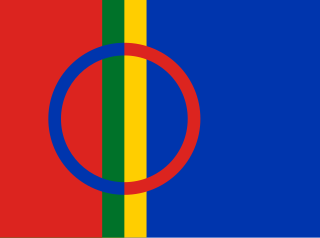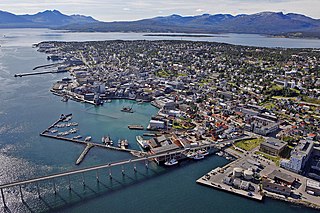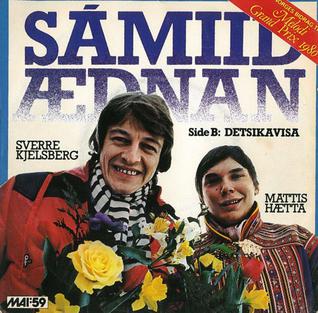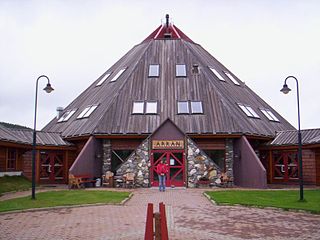Related Research Articles

Norway, formally the Kingdom of Norway, is a Nordic country in Northern Europe, situated on the Scandinavian Peninsula with a population of 5.5 million as of 2024. The remote Arctic island of Jan Mayen and the archipelago of Svalbard also form part of Norway. Bouvet Island, located in the Subantarctic, is a dependency; Norway also claims the Antarctic territories of Peter I Island and Queen Maud Land. The capital and largest city in Norway is Oslo.

Scandinavia is a subregion of Northern Europe, with strong historical, cultural, and linguistic ties between its constituent peoples. Scandinavia most commonly refers to Denmark, Norway, and Sweden. It can sometimes also refer to the Scandinavian Peninsula. In English usage, Scandinavia is sometimes used as a synonym for Nordic countries. Iceland and the Faroe Islands are sometimes included in Scandinavia for their ethnolinguistic relations with Sweden, Norway and Denmark. While Finland differs from other Nordic countries in this respect, some authors call it Scandinavian due to its economic and cultural similarities.

The Sámi are the traditionally Sámi-speaking Indigenous peoples inhabiting the region of Sápmi, which today encompasses large northern parts of Norway, Sweden, Finland, and of the Kola Peninsula in Russia. The region of Sápmi was formerly known as Lapland, and the Sámi have historically been known in English as Lapps or Laplanders, but these terms are regarded as offensive by the Sámi, who prefer their own endonym, e.g. Northern Sámi Sápmi. Their traditional languages are the Sámi languages, which are classified as a branch of the Uralic language family.

Sápmi is the cultural region traditionally inhabited by the Sámi people. Sápmi includes the northern parts of Fennoscandia, also known as the "Cap of the North".

Tromsø is a municipality in Troms county, Norway. The administrative centre of the municipality is the city of Tromsø. Other notable settlements in the municipality include the villages of Bjerkaker, Ersfjordbotn, Jøvika, Kaldfjord, Kjosen, Kroken, Kvaløysletta, Lakselvbukt, Melvika, Movik, Oldervik, Sandneshamn, Sjursnes, Sommarøy, and Tromsdalen.
A joik or yoik is a traditional form of song in Sámi music performed by the Sámi people of Sapmi in Northern Europe. A performer of joik is called a joikaaja, a joiker or jojkare. Originally, joik referred to only one of several Sami singing styles, but in English the word is often used to refer to all types of traditional Sami singing. As an art form, each joik is meant to reflect or evoke a person, animal, or place.

Kvens are a Balto-Finnic ethnic minority in Norway. They are descended from Finnish peasants and fishermen who emigrated from the northern parts of Finland and Sweden to Northern Norway in the 18th and 19th centuries. In 1996, Kvens were granted minority status in Norway, and in 2005 the Kven language was recognized as a minority language in Norway.

Gákti is the Northern Sámi word used by non-Sámi speakers to refer to many different types of traditional clothing worn by the Sámi in northern areas of Norway, Sweden, Finland and the Kola Peninsula in Russia. The gákti is worn both in ceremonial contexts and while working, particularly when herding reindeer. The traditional Sami outfit is characterized by a dominant color adorned with bands of contrasting colours, plaits, pewter embroidery, tin art, and often a high collar. In the Norwegian language the garment is called a 'kofte', and in Swedish it is called 'kolt'.

Lule Sámi is a Uralic, Sámi language spoken around the Lule River, Sweden, and in the northern parts of Nordland county in Norway, especially the Hamarøy municipality, where Lule Sámi is an official language. It is written in the Latin script, having an official alphabet.
Gaba or GABA may refer to:

"Sámiid ædnan" was the Norwegian entry in the Eurovision Song Contest 1980, performed by Sverre Kjelsberg and Mattis Hætta. The words of the song were performed in Norwegian by Sverre Kjelsberg, while Mattis Hætta contributed with the yoik chorus – a Sami form of vocal music without words; the title of the song is however in the Northern Sami language, translating as "Sami Land" or "Sami Soil". There are no actual Sami words in the yoik chorus – instead, the syllables "lo" and "la" are simply repeated, giving rise to another popular title for the song, "Låla".
Min Áigi was a twice-weekly Northern Sámi language newspaper based in Kárášjohka, Norway. In 2008, Min Áigi ceased publication to merge with the rival paper Áššu to form Ávvir.

Árran is the Lule Sámi center in the village of Drag in Hamarøy Municipality in Nordland county, Norway. The center was established in 1994 to foster and promote the Lule Sámi language and culture. It does this by arranging on-site and video conference courses in Lule Sámi, publishing books, and doing research. The center has a museum, a souvenir shop, and a Lule Sámi day-care center on its premises. One of the major projects that it was involved with was the Lule Sámi on-line course Sámasta and soon it will be publishing a Norwegian–Lule Sámi dictionary.

Nuorttanaste is a Northern Sámi religious publication based in Norway. It has published continuously since 1898, making it the longest running Sámi publication still being published.
Daerpies Dierie is a Southern Sámi church quarterly, founded in 1997 and headquartered in Snåsa, Norway. The magazine is financially supported by the Diocese of Härnösand in Sweden and the Diocese of Nidaros in Norway. The magazine's editor-in-chief and founder is Bierna Bientie. Articles are published in Swedish, Norwegian or Southern Sámi. The articles cover a wide range of topics, from Sami church life to more general news, church life, cultural life of the Sámi community.

Sámi languages, in English also rendered as Sami and Saami, are a group of Uralic languages spoken by the Indigenous Sámi people in Northern Europe. There are, depending on the nature and terms of division, ten or more Sami languages. Several spellings have been used for the Sámi languages, including Sámi, Sami, Saami, Saame, Sámic, Samic and Saamic, as well as the exonyms Lappish and Lappic. The last two, along with the term Lapp, are now often considered pejorative.
Sámi media refers to media in one of the Sámi languages or media that deals with Sámi-related issues in Norwegian, Swedish, English or some other non-Sámi language. The establishment of Sámi media in Norway coincides with the rise in nationalism there in the late 19th century. Much of the Sámi media has met the same fate over the years and been felled by a lack of funding or by going bankrupt.

Drita is an Albanian literary magazine published by the Association of the Young Modern Artists of Albania. Drita was one of the first magazines in the Albanian language. It has been published for 127 years with some interruptions.
Samefolket is a Sámi news magazine published from Jåhkåmåhkke, Sweden. Its motto is "Den Samiska Kultur- och Samhällstidskriften". Having published regularly since 1918, Samefolket is considered one of the oldest indigenous periodicals in the world.
Š Nuoraidmagasiidna, typically referred to simply as Š, is a Sámi quarterly magazine focused on music, movies, sports, and youth culture. Founded in 1993, it is published by Iđut AS in Billávuotna, Norway, and, as of 2020, its editor is Niels Ovllá Oskal Dunfjell. Š is primarily written in Northern Sámi, but it also includes articles in Southern Sámi, Lule Sámi, and Norwegian. It is distributed for free to eighth-grade students across Norway, as well as to students studying Sámi languages. The magazine is active on both Facebook and Instagram, and in 2021 launched a website offering content in Sámi languages, as well as Norwegian.
References
- ↑ Somby, Liv Inger (1998). Mediagirji[The Media Book] (in Northern Sami). Davvi Girji. pp. 30–31. ISBN 82-7374-355-1.
- ↑ Anti, Anne Berit (8 March 1996). "Sámi nissonbláđđi nissonbeaivái" [Sámi Women's Magazine on Women's Day]. Min Áigi (in Northern Sami). Vol. 4, no. 19. p. 12.
Gába, sámi nissonblđđi[ sic ] vuosttaš nummir boahtá nissonbeaivvi
[The first issue of Gába, a Sámi women's magazine, is coming out on women's day] - ↑ Gaski, Harald and Tr. John Weinstock. "Sámi Culture in the Nordic Countries – Administration, Support, Evaluation". University of Texas. Retrieved 28 June 2009.